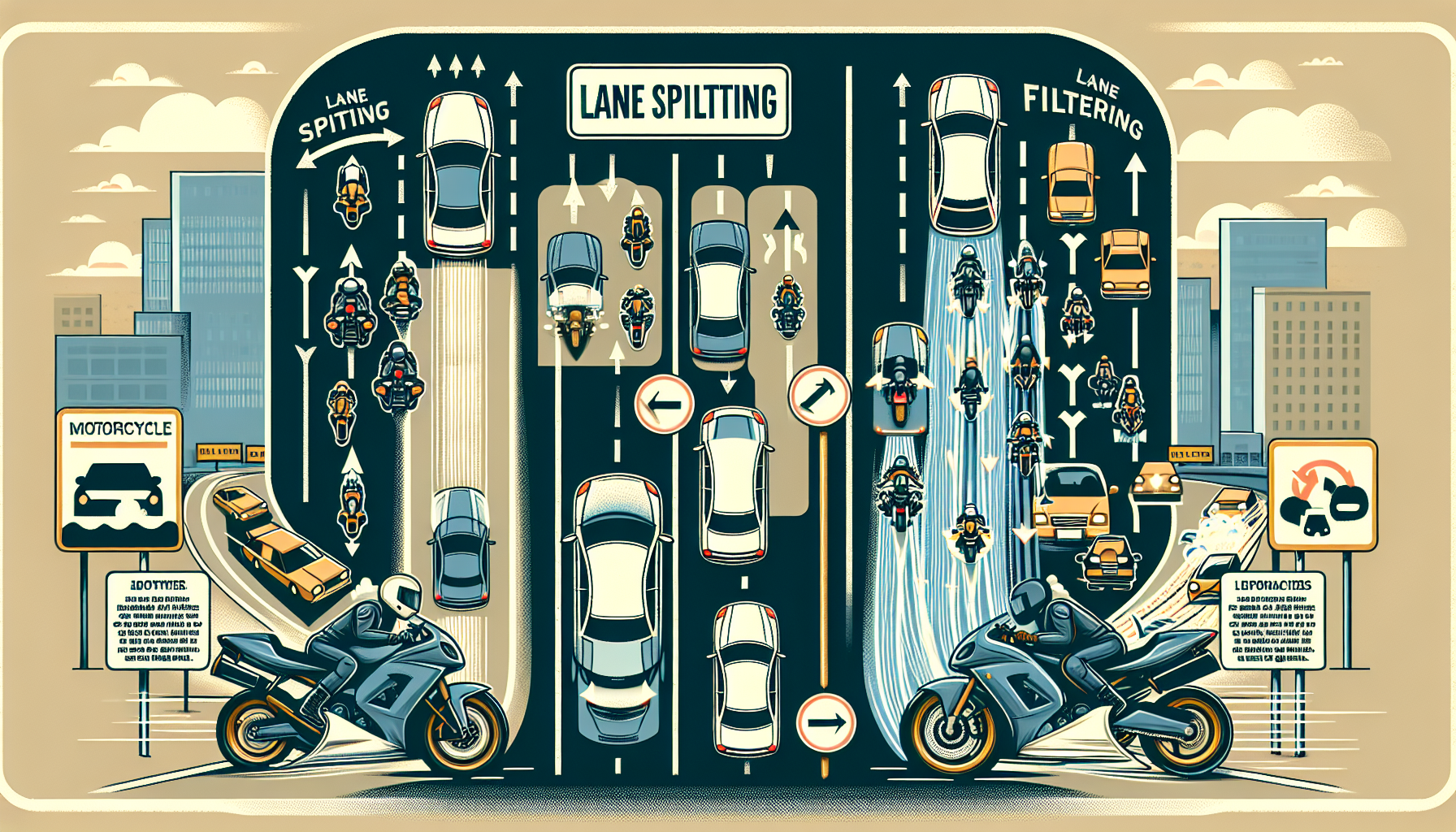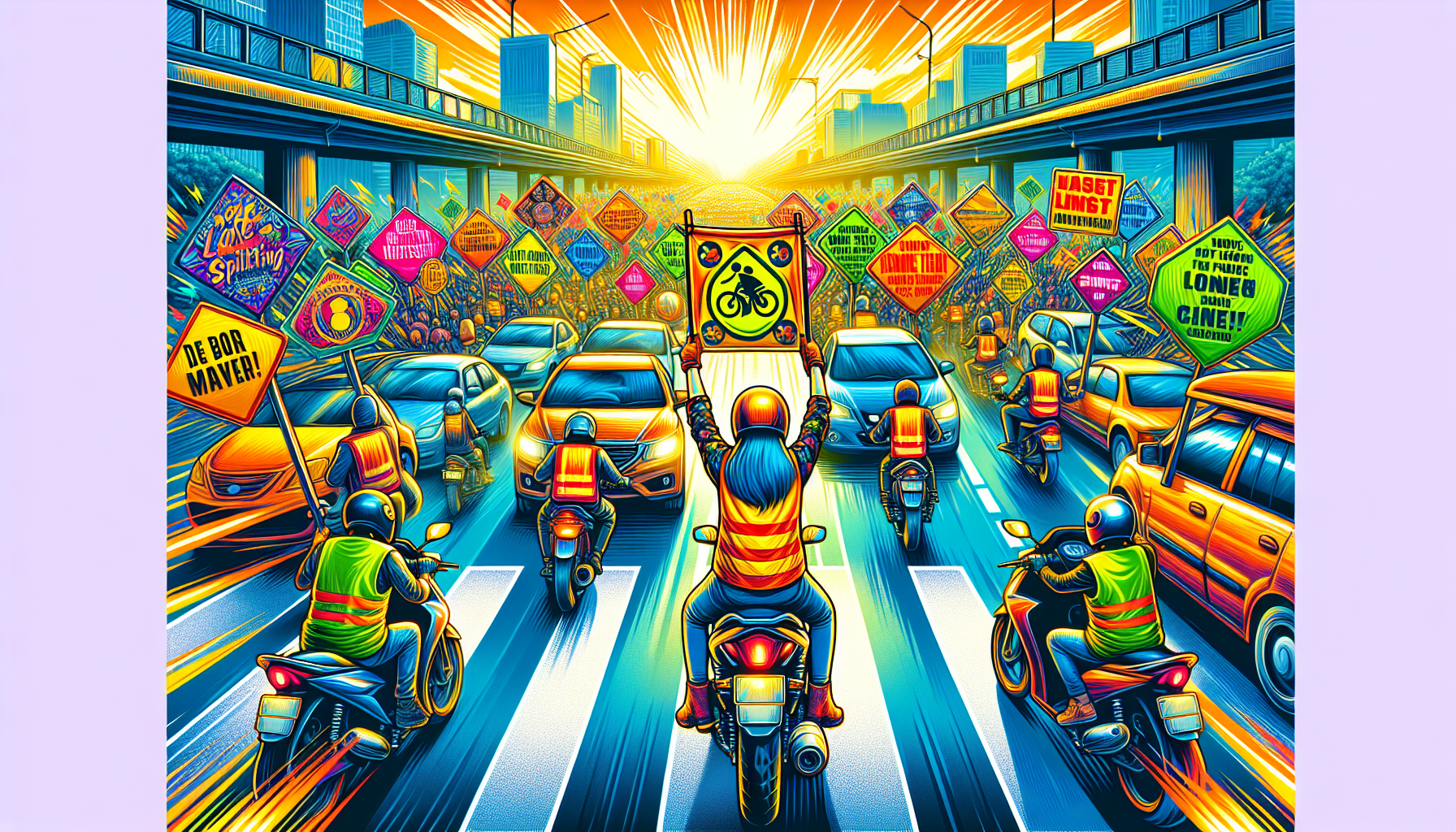Is lane splitting legal in Texas? No, it is not. Motorcyclists can’t ride between lanes of traffic and can get fined and ticketed. This article will cover the law, related practices, consequences and the ongoing legislative talks about lane splitting in Texas.
If you have any questions about your rights don’t hesitate to contact us.
Quick Facts
-
Lane splitting is illegal in Texas as of 2023, motorcyclists can’t ride between lanes of traffic and can get fined and charged with reckless driving.
-
Lane filtering is also illegal in Texas, lane sharing is allowed under certain circumstances but only with mutual agreement between motorcyclists.
-
Despite ongoing legislative talks and advocacy for lane splitting, past bills to allow lane splitting in Texas have failed, it’s a complex issue of safety vs traffic congestion.
Is Lane Splitting Legal in Texas?
As of 2023 lane splitting is illegal in Texas due to several laws. According to the Texas Transportation Code motorcyclists can’t drive between lanes of traffic, they must stay in one lane at all times. Lane splitting is a traffic violation that can get you fined, ticketed and even charged with reckless driving. Motorcyclists must follow these laws to avoid serious consequences.
Texas law prohibits motorcycles from splitting lanes under any circumstances. Violations will get you cited, fined and penalized. Motorcyclists in Texas must follow these rules to be safe and compliant.
Lane Splitting and Related Practices
Lane splitting is a controversial topic especially in Texas where it’s illegal. Understanding the difference between lane splitting, lane filtering and lane sharing is key to navigating this issue.
We’ll go over these definitions and distinctions to break down how motorcyclists interact with traffic.
What Is Lane Splitting?
Lane splitting is riding between lanes of slow moving or stopped vehicles, also known as stripe-riding or white-lining. This is to help motorcyclists get through traffic.
But the legality and safety of lane splitting varies from state to state so it’s a hot topic among riders and lawmakers. In some states riders can lane split, in others it’s illegal.
Lane Splitting vs Lane Filtering
Both lane splitting and lane filtering are illegal in Texas but they are different. Lane splitting is riding between lanes of stopped or slow moving traffic, lane filtering is moving to the front of stopped vehicles at a red light.
Some say lane filtering is a safer alternative to lane splitting but it’s still illegal in Texas.
Lane Sharing and Conditions
Lane sharing or riding side by side in the same lane is allowed in Texas under certain circumstances. Both riders must agree to ride side by side without impeding traffic.
This is legal as long as it doesn’t impede traffic and both motorcyclists agree to it.
Consequences and Penalties
Lane splitting in Texas has consequences beyond just breaking a traffic law. Motorcyclists get cited, fined and even charged with reckless driving.
Knowing these consequences is important for anyone considering Texas lane splitting laws.
Penalties for Lane Splitting in Texas
Penalties for lane splitting in Texas are steep. Fines start at $175 but can go up to $200. In serious cases involving reckless driving fines can also include up to 30 days in jail. Lane splitting can also get you charged with unsafe lane change.
If you get ticketed for lane splitting stay calm and polite with the officer. Review the ticket carefully and consult with a traffic ticket attorney if needed to understand the violation and contest options.
Reckless Driving
Reckless driving is operating a vehicle with willful disregard for safety. Lane splitting can get you charged with reckless driving if deemed too aggressive or unsafe.
These charges come with heavy penalties, fines, points on your license and higher insurance rates.
Legislative History and Background
Lane splitting has been a hot topic in Texas for years with varying public opinions and support from lawmakers.
We’ll go over past legislative attempts and current discussions on lane splitting to give you the full history of lane splitting in Texas.
Past Attempts to Legalize Lane Splitting
Multiple bills have been filed to legalize lane splitting in Texas but none have passed. Despite these efforts lane splitting is still illegal as of 2023. A 2023 bill allowed lane splitting under certain conditions but failed.
These failed bills show the difficulties in legalizing lane splitting in Texas. Lawmakers can’t seem to balance the benefits of reduced traffic with the risks.
This debate will continue to shape lane splitting laws in the state.
Current Discussions
Lane splitting is still being discussed in Texas legislative circles. Proponents say it eases congestion and may reduce rear end collisions.
Motorcyclists stay tuned.
Safety and Advocacy
Safety is the core of the lane splitting debate. While some studies say it reduces traffic and increases safety for motorcyclists others say it introduces new risks.
We’ll go over both sides of the argument and look at the role of advocacy in shaping public and legislative opinion.
Safety Risks of Lane Splitting
Safety for motorcyclists and other drivers has caused many states including Texas to hesitate in legalizing lane splitting. The risk of reckless driving charges increases due to the dangers of limited visibility and other drivers making sudden lane changes.
Motorcyclists can increase safety by using headlights and wearing bright clothing to be more visible. Keeping a safe distance from other vehicles and using turn signals to indicate your intentions is key to avoiding accidents.
Lane splitting at higher speeds should be avoided as it increases the chances of a lane splitting accident.
Reasons to Legalize Lane Splitting
Advocates say legalizing motorcycle lane splitting would reduce traffic and increase safety for motorcyclists. California where it is legal has shown it can be done safely with guidelines like splitting lanes 10 mph above the surrounding traffic.
Reduced traffic and increased safety is a strong case for lane splitting.
Reasons Not to Legalize Lane Splitting
Opponents say lane splitting is a risk for motorcyclists and other drivers. They argue it makes safe lane changes for motorists more complicated and increases the risk of accidents.
These reasons against lane splitting.
Other States
Texas’s stance on lane splitting is different from other states especially California. We’ll compare the laws and experiences to show the pros and cons of legalizing lane splitting.
These are good to know for Texas lawmakers and motorcyclists.
Lane Splitting Laws in the U.S.
California is the only U.S. state that has legalized lane splitting. A study by Berkeley researchers found that less than 1% of 6,000 motorcycle accidents involved lane splitting so it may not increase accident rates.
This is good data for states like Texas considering lane splitting.
California’s Experience
The California Highway Patrol (CHP) has guidelines to promote safe lane splitting. Texas can learn from California’s implementation by looking at the effectiveness of these guidelines.
Texas can learn from California’s experience and use it for future legislation and make lane splitting safer.
Tips for Motorcyclists in Texas
Since lane splitting is illegal in Texas motorcyclists need to be extra cautious and informed.
Here we’ll give you practical tips for riding in Texas legally and safely, same traffic laws and patience.
Riding in Heavy Traffic
Motorcyclists in Texas should put themselves and others first in heavy traffic. Since lane splitting is illegal use designated motorcycle lanes and high occupancy vehicle lanes as safer options. Always use turn signals to indicate your intentions to other drivers.
In heavy traffic keep a safe distance from other vehicles and don’t make sudden lane changes to reduce risk of accident. Patience and following traffic laws is key as the temptation to lane split can lead to serious legal and safety consequences.
What to Do if Ticketed for Lane Splitting
If ticketed for lane splitting in Texas stay calm and know your rights. Address the ticket ASAP to avoid further penalties. Knowing your options and the ticket’s consequences is key to resolving it.
What to do with the ticket is to review it carefully and consult an attorney specializing in traffic violations if needed. This will give you guidance if you think the ticket is unfair.
Lane Splitting in Texas Future
Future changes in Texas lane splitting laws may be driven by public discussion and rider advocacy. The recent law that allows police officers and two motorcycles to ride side by side in the same lane shows that they are open to changing motorcycle related traffic laws.
As public opinion and legislation evolves there may be opportunity to legalize lane splitting under certain conditions. Advocacy groups are pushing for change citing benefits in other states like California.
The Texas legislature during the next legislative session will decide if lane splitting will be legal in the state.
Conclusion
In summary lane splitting is still illegal in Texas and the penalties are severe. Motorcyclists need to understand the difference between lane splitting, lane filtering and lane sharing to ride safely and legally. The legislative history and ongoing discussion is complicated and controversial.
As Texas considers changing its lane splitting laws motorcyclists need to stay informed and advocate for safe and practical solutions. Whether lane splitting will be legal in the future is unknown but staying engaged in the legislative process and prioritizing safety on the roads will be key for all riders.
FAQs
Why is lane splitting legal in Texas?
Lane splitting is illegal in Texas because it’s considered unsafe under current state traffic laws. Lane splitting which is riding a motorcycle between lanes of slower or stopped traffic is seen as increasing the risk of accident due to limited space and reduced reaction time for both motorcyclists and other drivers. Texas law prioritizes safety and uniformity on the roads and while some states allow lane splitting Texas has chosen to keep it illegal to minimize the risks.
What is the difference between lane splitting and lane filtering?
Lane splitting is riding between lanes of slow moving or stopped traffic, lane filtering is riding to the front of stopped vehicles at a red light. Both are illegal in Texas.
What are the penalties for lane splitting in Texas?
Lane splitting in Texas can result in fines usually ranging from $175 to $200, with more severe violations potentially incurring fines of up to $200 and a jail term of up to 30 days. It is advisable to adhere to traffic regulations to avoid these penalties.
Can you go between cars on a motorcycle in Texas?
In Texas, you cannot legally ride a motorcycle between cars, a practice known as lane splitting. Texas law requires motorcycles to stay within a single lane and does not allow them to weave between vehicles, even in heavy traffic. This rule is in place for safety reasons, as lane splitting can increase the risk of collisions due to limited space and reduced visibility. Riding between cars could result in a traffic citation or other legal consequences, so it’s best to follow the standard lane rules while on Texas roads.
Are there any ongoing efforts to legalize lane splitting in Texas?
Yes, Texas lawmakers are actively discussing the legalization of lane splitting, with advocacy groups highlighting its potential benefits as seen in states like CaliforniIn summary lane splitting is still illegal in Texas and the penalties are severe. Motorcyclists need to understand the difference between lane splitting, lane filtering and lane sharing to ride safely and legally. The legislative history and ongoing discussion is complicated and controversial.
As Texas considers changing its lane splitting laws motorcyclists need to stay informed and advocate for safe and practical solutions. Whether lane splitting will be legal in the future is unknown but staying engaged in the legislative process and prioritizing safety on the roads will be key for all riders.












